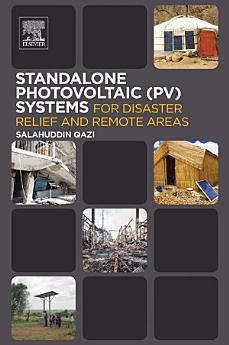Standalone Photovoltaic (PV) Systems for Disaster Relief and Remote Areas
Salahuddin Qazi
Aug 2016 · Elsevier
3.0star
2 reviewsreport
Ebook
308
Pages
family_home
Eligible
info
reportRatings and reviews aren’t verified Learn More
About this ebook
Standalone Photovoltaic (PV) Systems for Disaster Relief and Remote Areas explores the increased demand for energy, including clean energy alternatives and the ways that solar energy is fast becoming a vital source for meeting peak demand, a solution for energy demand in disaster and remote areas, and a viable source to meet emerging energy security needs. The book provides a detailed overview of PV systems and applications for disaster and remote areas, and includes a guide on how to provide electricity during outages, along with important discussions on the need for increasing the resilience of the grid. The differences and requirements for standalone, mobile, and portable PV systems are discussed, along with how systems can be deployed, transported, and used in remote areas. In addition, the book discusses the use of solar PV systems to create environmentally friendly power systems for remote communities that can be operated independently, also comparing the costs, emissions, and practical applications of other technologies. - Types of natural disasters, their effect on peoples' lives, on world economy, impact on electric grid and costs of power outages - Energy Needs in the aftermath of disasters and remote areas both in developed and developing Countries, including how PV systems can provide electricity affordably, with resilience and reducing grid impact by way of community solar and solar microgrid - Detailed description of the types and components of standalone photovoltaic systems, modeling and simulation and performance analysis - New initiatives, programs and case studies for providing solar-generated electricity to low-income people both in the United States and the developing world at low cost - Examples of assembling one's own PV module and dye-sensitized solar cells, results, databases and industry standards
Ratings and reviews
3.0
2 reviews
Han Duo (Hansolo)
- Flag inappropriate
June 11, 2018
I want my money back...
Anil Das
- Flag inappropriate
January 23, 2021
AAA
About the author
Prior to becoming an Emeritus Professor, he spent a year completing a project on developing instructional material for an NSF-funded project on "Visualization and Manipulation of Nanoscale Components using Atomic Force Microscopy. For the last 30 years at SUNYIT, he taught and developed courses in the area of fiber optics, wireless communication, optical communications, nanotechnology, photovoltaic energy, computer and data communication. During his tenure at SUNYIT, he was chairman of the EET department, coordinator of the photonics program and Director of the Master of Science program in advanced technology, which he helped to develop. Professor Qazi is a recipient of several awards including the William Goddel award for research creativity at SUNYIT and engineering professionalism by Mohawk Valley Engineering Executive Committee. Professor Qazi forged closer relations with the IEEE Mohawk Valley section, is a life member of IEEE and a member of American Society of Engineering Education. He holds a Ph.D. degree in Electrical engineering from Loughborough University, U.K.
Rate this ebook
Tell us what you think.
Reading information
Smartphones and tablets
Install the Google Play Books app for Android and iPad/iPhone. It syncs automatically with your account and allows you to read online or offline wherever you are.
Laptops and computers
You can listen to audiobooks purchased on Google Play using your computer's web browser.
eReaders and other devices
To read on e-ink devices like Kobo eReaders, you'll need to download a file and transfer it to your device. Follow the detailed Help Center instructions to transfer the files to supported eReaders.




